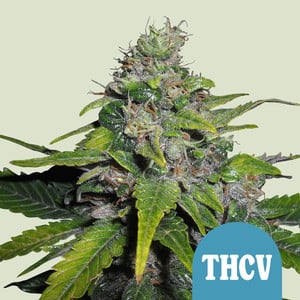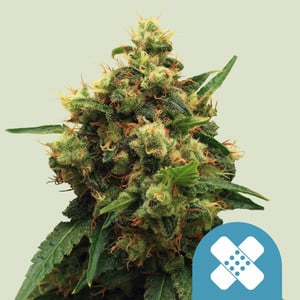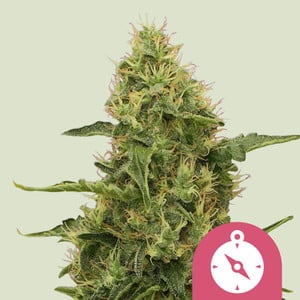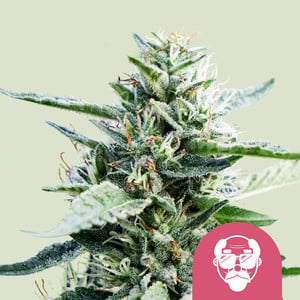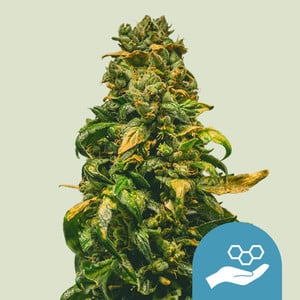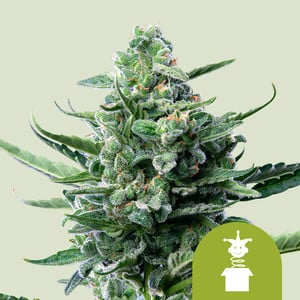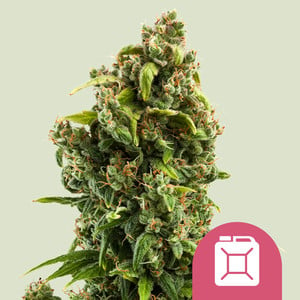.

The Best Anxiety-Friendly Cannabis Strains
Not every cannabis experience has to end with you feeling paranoid, anxious, and panicky; there's more to weed than getting super stoned! Explore some of these low-THC varieties to feel grounded and clear-headed when you smoke. Experience the effects of THCV, high levels of CBD, and soothing terpenes.
Contents:
Key Points
- Early studies are exploring the impact of cannabis on anxiety.
- While the herb might help some people relax, it worsens anxiety in others.
- However, not all weed strains are the same; those lower in THC are generally more anxiety-friendly.
- Discover the link between weed and anxiety and meet some suitable strains below.
Some users report a reduction in mental tension and worry after using cannabis, whereas others feel much more anxious after hitting a joint. Ultimately, the effects of the herb vary dramatically depending on the strain and the individual using it.
Below, we’re going to uncover the complex relationship between anxiety and cannabis. Then, we’ll take a look at how the herb might impact ADHD and OCD—two closely linked conditions. Finally, we’ll suggest a handful of strains that are less likely to trigger anxiety when smoked—as well as some to avoid.
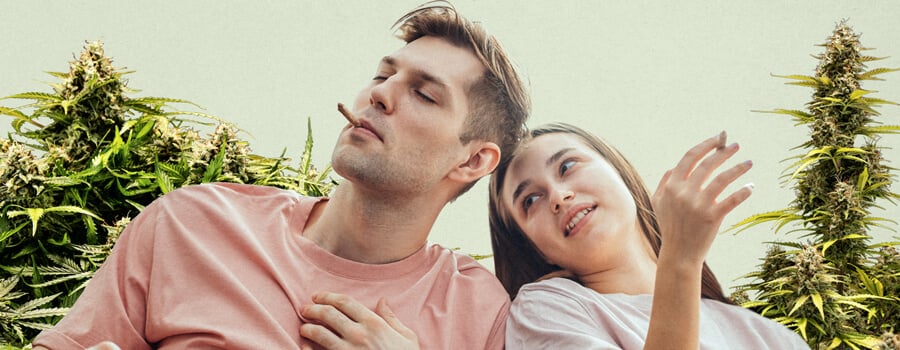
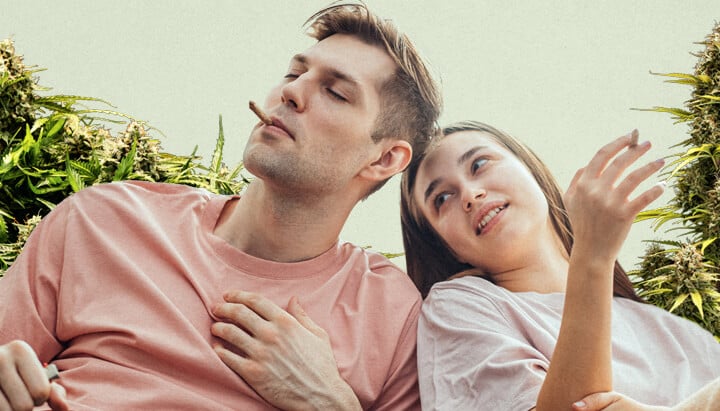
How Cannabis Influences Anxiety
The effects of cannabis on the body and mind are the result of the interplay between hundreds of chemical compounds found in cannabis flowers. Each strain contains a different cocktail of these molecules, giving it a unique effect on the central nervous system.
Cannabinoids are among the most important phytochemicals found in the plant. These include THC and CBD, alongside over 100 lesser-known compounds. Cannabinoids primarily exert their effects through the receptors, enzymes, and ligands of the endocannabinoid system (ECS)—a complex signalling network found in the brain and all throughout the body.
The ECS plays an important role in regulating anxiety and stress. The activation of ECS receptors by endogenous compounds holds sway over neurotransmission in the brain and generally produces an anxiolytic (anxiety-reducing) effect.
-
The Role of Cannabinoids
Certain compounds in cannabis, including THC and various terpenes, bind to ECS receptors, mimicking the signalling molecules that our bodies produce to manage this system. More specifically, THC produces its psychoactive effects by binding to the CB1 receptor in the brain. However, the cannabinoid works in a biphasic manner[1]. Research suggests that low doses are correlated with anxiety-reducing effects, whereas high doses are linked to the exacerbation of anxiety.
Upon binding to the CB1 receptors, THC causes a surge of dopamine[2] in the brain—a “feel-good” neurochemical linked to reward. However, too much THC can cause overactivation of the amygdala—a region of the brain involved in the fight-or-flight response.
Cannabidiol (CBD) ranks as the second-most abundant cannabinoid in most strains. This compound exhibits a low affinity for ECS receptors but modulates the system by acting on certain enzymes[3] and other sites, such as serotonin, vanilloid, and other receptors. Researchers are investigating CBD for anti-anxiety effects in humans by monitoring its impact on social anxiety in public speaking simulations[4] and its influence on blood flow[5] to certain regions of the brain.
While other cannabinoids remain less studied, recent investigations have probed cannabigerol (CBG) for its effects on anxiety[6], stress, and mood in humans.
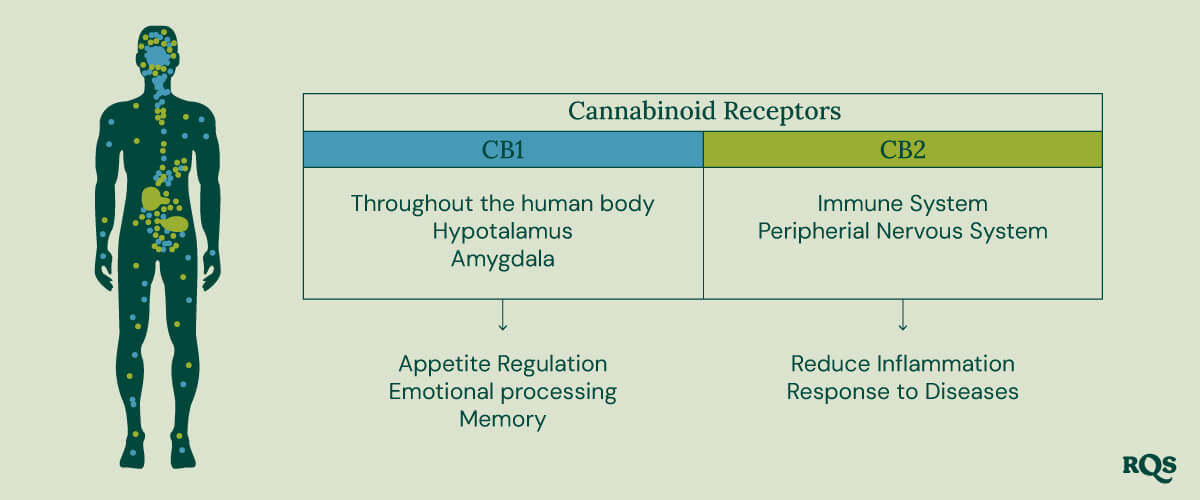
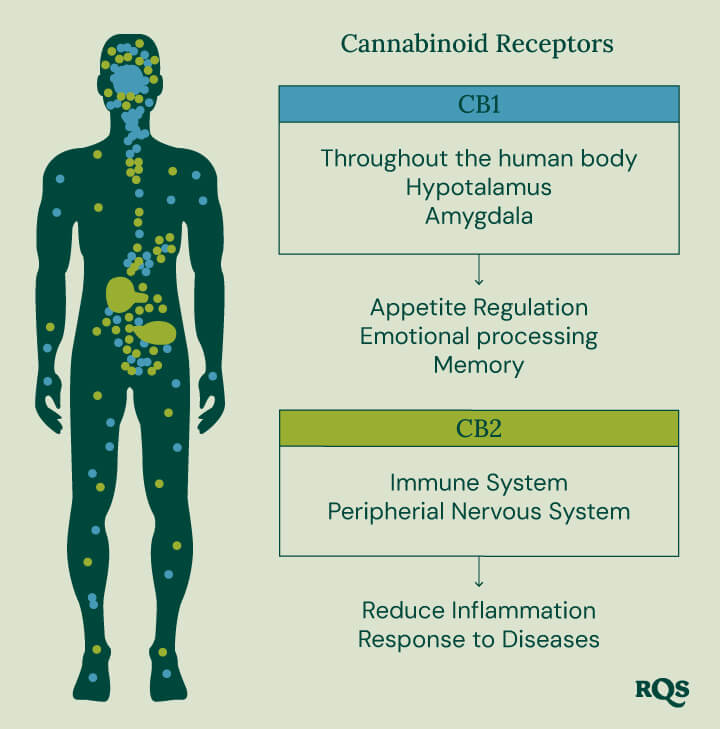
-
The Influence of Terpenes
Alongside cannabinoids, cannabis also produces over 100 terpenes. These aromatic molecules are largely responsible for the unique flavour and aroma of particular strains. However, they also steer the effects of the high—making the cannabis experience more relaxing or energising.
Research shows that select terpenes, much like THC, also bind[7] to CB1 receptors; others are able to bind to CB2 and other ECS sites. Researchers have tested a range of the most common cannabis terpenes in models of anxiety. These compounds include limonene, caryophyllene, linalool, pinene, and terpinolene.
Characteristics of Strains That Minimise Anxiety
The research regarding the effects of cannabis on anxiety remains inconclusive. However, data from preliminary studies and anecdotal reports paints a picture of which molecules seem to worsen anxiety and which potentially reduce feelings of nervousness and agitation. With this in mind, let’s explore the types of relaxing weed strains that show promise in this area.
-
Low-THC, High-CBD Strains
If you’re searching for the best weed to smoke if you get paranoid easily, then you’ll certainly want to pay attention to THC concentrations. Remember, high levels of this psychoactive constituent heighten feelings of anxiety.
On the other hand, strains that are low in THC are thought to elevate dopamine levels without over-activating the amygdala. Research also suggests that CBD “blunts” the effects of THC, helping to lessen adverse events[8] such as THC-induced anxiety.
-
Terpenes That Promote Relaxation
Terpenes also play a significant role in the effects of each strain. Some of them are stimulating while others are more mellow and relaxing. The key terpenes to look out for when seeking the best strain for anxiety include:
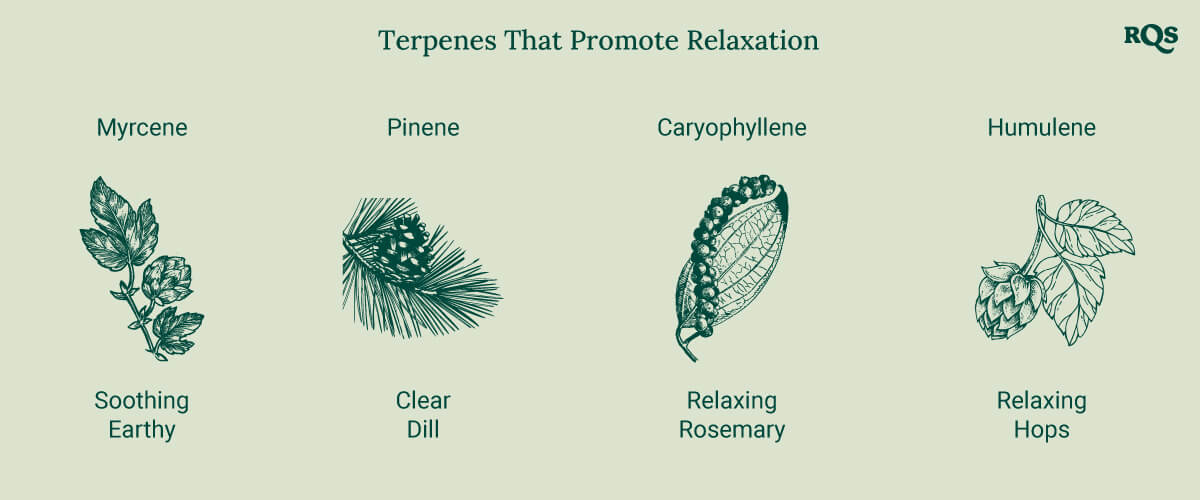
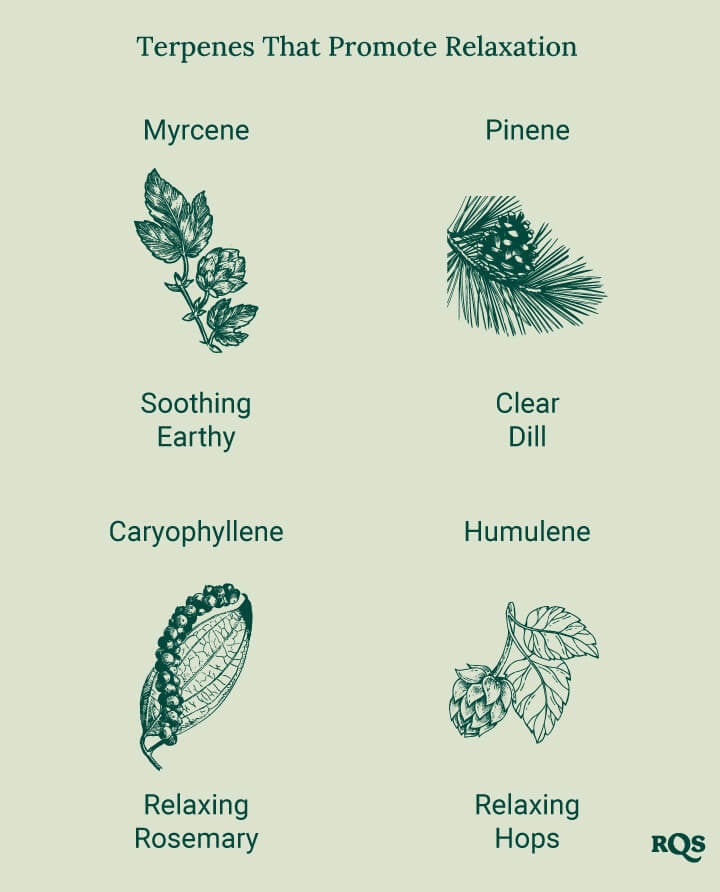
-
Indica vs Sativa for Anxiety
Many cannabis users often wonder: “Does sativa help my anxiety?”. Popular cannabis culture has made a distinction between sativa and indica genetics, claiming that the former produces a stimulating effect and the latter induces relaxation.
In reality, this distinction of effects is not so straightforward. “Indica” and “sativa” refer to distinct subspecies of cannabis that differ in their morphology—their size, shape, and other visual characteristics. While useful, these terms do little to describe the effects of a certain strain, regardless of their widespread use in this regard.
When considering which strain is good for anxiety, don’t make your pick based on the cultivar's strain type alone. Instead, make your choice based on its chemical profile; look at its THC and CBD content and which terpenes are most abundant.
If you’ve ever questioned: “Why does sativa make my anxiety worse?”, look at the other qualities of the strain you’re using. Disregard its morphology and focus on its THC content and key terpenes.
Specific Cannabis Strains and Anxiety
Now, let’s take a look at some of the most relaxing weed strains available. These cultivars haven’t been studied for their impact on anxiety, but users generally agree that these varieties help them to unwind and relax.
-
Royal THCV
Royal THCV offers a 7% concentration of its namesake cannabinoid alongside 7% THC. At low doses, THCV may help to dampen the effects of THC; at high doses, it produces a euphoric effect.
Overall, this strain offers a clear-headed and creative effect. Its low quantities of THC make it a great choice when looking to relax, exerting a subtle and gentle psychoactive effect. Enjoy flavours of earth, fruit, and herbs and bulky indoor yields of 500–550 g/m².
Royal THCV
|
|
Pure African Sativa x Durban Haze |
|
|
500 - 550 gr/m2 |
|
|
80 - 120 cm |
|
|
9 - 10 weeks |
|
|
THC: 7% |
|
|
Sativa 95% Indica 5% |
|
|
425 - 475 gr/plant |
|
|
140 - 180 cm |
|
|
Late October |
|
|
Clear, Motivating , Uplifting |
|
|
7% |
-
Painkiller XL
With a THC content of just 9% and high levels of CBD, Painkiller XL serves up a gentle, clear-headed, and physically relaxing experience. Most users can smoke these buds during the day and stay fully functional.
As the offspring of Respect 13 and Juanita la Lagrimosa, Painkiller XL contains high levels of the terpenes caryophyllene and pinene, which contribute to her pleasant effects. Enjoy indoor yields of up to 550 g/m² after a blooming period of 8–9 weeks.
Painkiller XL
|
|
Respect 13 x Juanita la Lagrimosa |
|
|
500 - 550 gr/m2 |
|
|
60 - 100 cm |
|
|
8 - 9 weeks |
|
|
THC: 9% |
|
|
Sativa 75% Indica 25% |
|
|
500 - 550 gr/plant |
|
|
120 - 150 cm |
|
|
Late September |
|
|
Clear, Physically Relaxing |
-
Northern Light
As one of the most relaxing indica strains, Northern Light pairs a THC content of 18% with fruity and peppery terpenes. Slightly more potent, this variety is a great option to kick back and relax for users who are less sensitive to THC.
As a direct descendant of Northern Light S1, this variety offers returns of 500–550 g/m² when grown indoors in optimal conditions.
Northern Light
|
|
Northern Light S1 |
|
|
500 - 550 gr/m2 |
|
|
100 - 160 cm |
|
|
8 - 9 weeks |
|
|
THC: 18% |
|
|
Sativa 0% Indica 100% |
|
|
575 - 625 gr/plant |
|
|
180 - 220 cm |
|
|
Late September |
|
|
Balanced, Clear, Stoned |
-
Granddaddy Purple
If you’re wondering what other strains of weed don’t cause anxiety, you might get on well with Granddaddy Purple. Derived from parents Purple Urkle and Big Bud, this indica-dominant hybrid possesses a THC content of 20%.
However, high levels of the terpene myrcene make for a deeply relaxing experience. Enjoy flavours of herbs, pine, and pepper as her muscle-melting effects take hold.
Granddaddy Purple
|
|
Purple Urkle x Big Bud |
|
|
450 - 500 gr/m2 |
|
|
70 - 120 cm |
|
|
8 - 10 weeks |
|
|
THC: 20% |
|
|
Sativa 25% Indica 75% |
|
|
550 - 600 gr/plant |
|
|
120 - 150 cm |
|
|
Early October |
|
|
Euphoric, Physically Relaxing, Sleepy |
-
Solomatic CBD
If you’re hypersensitive to THC and find most strains cause you to feel anxious, Solomatic CBD has your back. With a CBD concentration of 21% and just 1% of THC, this autoflowering strain produces a clear-headed experience with no detectable psychotropic effect.
Moreover, plants reach just 100 cm indoors (50 cm when trained) and produce a rewarding 150–200 g/m² after an entire growing cycle of just 10–11 weeks.
Solomatic CBD
|
|
Diesel CBD x Asia CBD Auto |
|
|
150 - 200 gr/m2 |
|
|
50 - 100 cm |
|
|
7 - 8 weeks |
|
|
THC: 1% |
|
|
Sativa 20% Indica 70% Ruderalis 10% |
|
|
30 - 80 gr/plant |
|
|
60 - 100 cm |
|
|
10 – 11 weeks after sprouting |
|
|
Clear, Light |
Can Cannabis Help ADHD and OCD?
Anxiety, attention-deficit/hyperactivity disorder (ADHD), and obsessive-compulsive disorder (OCD) share some biological and psychological pathways, including possible imbalances in dopamine and amygdala dysregulation.
Studies on the impact of cannabis on ADHD and OCD remain early and limited. However, the ties between these two conditions and anxiety are certainly interesting and worthy of investigation in the context of cannabis research.
Specific Strains for ADHD & OCD
No placebo-controlled trials have assessed the effectiveness of specific cannabis strains on the symptoms of ADHD and OCD. Regardless, the two cultivars below are certainly soothing and relaxing.
-
Royal Jack Auto
Quick, small, and compact, Royal Jack Auto darts from sprout to harvest in just 11–12 weeks. Convenience aside, this sativa-dominant hybrid possesses a THC content of 16% and a creative yet controlled high.
Royal Jack Auto
|
|
Jack Herer x Ruderalis |
|
|
350 - 400 gr/m2 |
|
|
40 - 80 cm |
|
|
7 - 8 weeks |
|
|
THC: 16% |
|
|
Sativa 40% Indica 30% Ruderalis 30% |
|
|
70 - 120 gr/plant |
|
|
60 - 80 cm |
|
|
11 - 12 weeks after sprouting |
|
|
Creative, Motivating |
-
Sour Diesel
Stemming from Original Diesel, Northern Light, Shiva, and Hawaiian genetics, Sour Diesel features a sativa-dominant genetic profile. Her THC content of 19% synergises with her fruity and peppery terpene profile, producing a clear-headed and mellow effect. Enjoy indoor returns of up to 525 g/m².
Sour Diesel
|
|
Original Diesel x (Northern light x Shiva x Hawaiian) |
|
|
475 - 525 gr/m2 |
|
|
90 - 160 cm |
|
|
10 - 11 weeks |
|
|
THC: 19% |
|
|
Sativa 70% Indica 30% |
|
|
550 - 600 gr/plant |
|
|
150 - 200 cm |
|
|
Late October |
|
|
Clear, Physically Relaxing |
Strains to Avoid for Anxiety-Prone Users
Now that you’re aware of the top strains to help combat nervousness and worry, what strains are bad for anxiety?
If you find yourself spiralling into anxiety and panic every time you smoke, do yourself a favour and avoid the genetics listed below.
-
Green Crack
With a telling name, Green Crack exerts an excitable and energising high. While these buds only contain a THC content of 17%, the overall chemical profile produces an effect that some users find too stimulating and unpleasant.
-
Modified Bananas
As one of the strongest strains ever created, Modified Bananas features an outlandish THC content of 31%. Just a single toke of these buds could send some sensitive smokers over the edge.
-
Kush Mints
Similarly, Kush Mints clocks in with a titanic THC content of 28%. This high concentration is enough to cause an uncomfortable experience even in seasoned smokers.
-
GMO Cookies
Also known as Garlic Cookies, you should avoid GMO Cookies if you find high levels of THC send you into an anxiety spiral. With concentrations of 28%, this variety will likely elevate anxiety and rumination, even if you pace yourself.
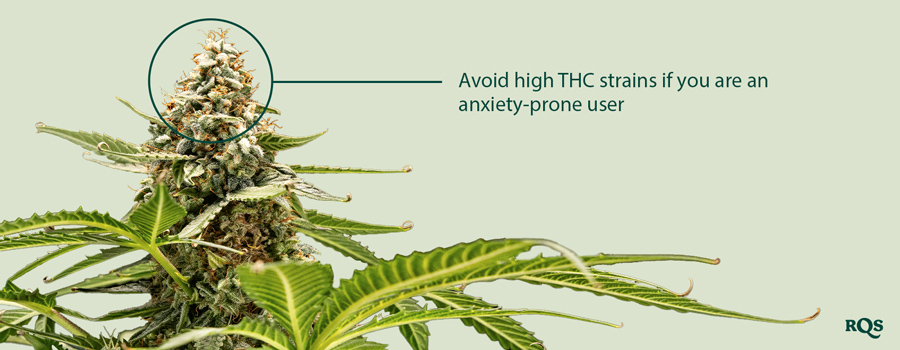
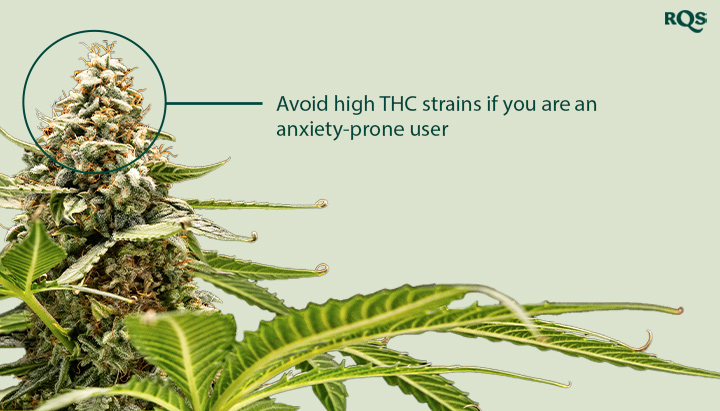
Dosing and Consumption Tips
Even when using suitable strains with low THC levels, there’s always a possibility of overdoing things. Follow these simple tips for the best experience possible:
- Go low and slow: Take a couple of hits, then wait. Repeat this process until you reach your sweet spot.
- Avoid edibles: Eating cannabis edibles causes THC to convert into a much more potent metabolite in the body. Stick to smoking or vaping for a shorter and more manageable experience.
- Stay hydrated: Drink plenty of fluids to avoid unpleasant side effects such as cotton mouth.
- Consider set and setting: Smoke in a cosy environment where you’re unlikely to be interrupted. Invite your close and trusted friends to enjoy these strains with you.
Enjoy Anxiety-Friendly Strains With Confidence
If you’ve found yourself having negative cannabis experiences recently, try switching things up. You don’t have to smoke high-THC varieties every time you blaze. Give the aforementioned anxiety-friendly cultivars a go-to experience soothing, mellow, and clear-headed effects instead!
- The endocannabinoid system in guarding against fear, anxiety and stress - PMC https://pmc.ncbi.nlm.nih.gov
- The effects of Δ9-tetrahydrocannabinol on the dopamine system - PMC https://pmc.ncbi.nlm.nih.gov
- Cannabidiol enhances anandamide signaling and alleviates psychotic symptoms of schizophrenia - PMC https://pmc.ncbi.nlm.nih.gov
- Cannabidiol Reduces the Anxiety Induced by Simulated Public Speaking in Treatment-Naïve Social Phobia Patients - PMC https://pmc.ncbi.nlm.nih.gov
- Cannabidiol has a unique effect on global brain activity: a pharmacological, functional MRI study in awake mice | Journal of Translational Medicine | Full Text https://translational-medicine.biomedcentral.com
- Acute effects of cannabigerol on anxiety, stress, and mood: a double-blind, placebo-controlled, crossover, field trial | Scientific Reports https://www.nature.com
- A closer look at cannabimimetic terpenes, polyphenols, and flavonoids: a promising road forward - PMC https://pmc.ncbi.nlm.nih.gov
- Clinical and Preclinical Evidence for Functional Interactions of Cannabidiol and Δ9-Tetrahydrocannabinol - PMC https://pmc.ncbi.nlm.nih.gov


























